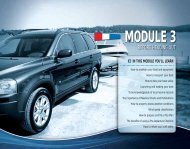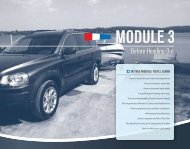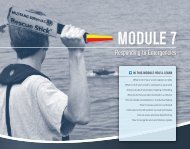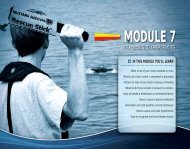MODULE 6 - BOATsmart!
MODULE 6 - BOATsmart!
MODULE 6 - BOATsmart!
You also want an ePaper? Increase the reach of your titles
YUMPU automatically turns print PDFs into web optimized ePapers that Google loves.
THE CARDINAL SYSTEM<br />
106 I Module 6<br />
The cardinal system<br />
The cardinal buoy system consists of yellow and black<br />
buoys that are used to assist boaters in identifying the<br />
location of safe water. Safe water lies on the North,<br />
South, East or West side of the buoys. For example,<br />
a North Cardinal Buoy indicates that safe water lies<br />
to the North of the buoy. Cardinal buoys may be<br />
equipped with a light and/or letters for identification<br />
on a marine chart. Remember: With cardinal buoys,<br />
safest water lies in the direction indicated by the<br />
buoy. Water in the opposite direction should be<br />
considered unsafe and avoided.<br />
Cardinal markers are spar or pillar shaped (with a<br />
flat top). The position of the yellow and black colour<br />
bands indicates the cardinal compass point of North,<br />
South, East or West and therefore the direction of the<br />
safest water. If so equipped, top-marks consisting of<br />
two cones indicate the direction of safe water. Specific<br />
details on each type of Cardinal Buoy can be found in<br />
the “Chart of Buoys” on page 109.<br />
CARDINAL BUOYS AND THEIR SIGNAL LIGHTS<br />
Cardinal buoys may be equipped with a flashing white light for reference when navigating at night.<br />
North flashes once; South flashes in a group six times followed by one long flash; East flashes in a group<br />
three times; and West flashes in a group nine times. The chart below depicts the pattern of flashing white light<br />
for each type of buoy.<br />
West buoys flash at<br />
the rate of 9 times in<br />
fifteen seconds. A very<br />
quick flash can also be<br />
used – 9 flashes every<br />
ten seconds<br />
W EST<br />
0 sec.<br />
15<br />
Q(9)15S<br />
0 sec.<br />
-VQ(9)10S<br />
OR<br />
10<br />
NW<br />
N ORTH<br />
S<br />
O UT<br />
H<br />
0 sec. 5 10 15<br />
(Q)1S<br />
OR<br />
0 sec. 5 10 15<br />
-(VQ).5S<br />
N<br />
0 sec.<br />
15<br />
(Q(6)+LF1)15S<br />
OR<br />
0 sec. 10<br />
(VQ(6)+LF1)10S<br />
WHITE<br />
LIGHT<br />
W E<br />
SW<br />
South buoys flash at a rate of 6 times in<br />
15 seconds followed by a single long flash.<br />
A very quick flash can also be used –<br />
6 flashes every ten seconds plus 1 longer<br />
flash at the end of each group to mark<br />
the end of a single flash cycle.<br />
WHITE<br />
LIGHT<br />
DANGER<br />
WHITE<br />
LIGHT<br />
S<br />
North buoys flash at a rate<br />
of 1 per second or 60 per<br />
minute. A very quick flash<br />
can also be used – 10 flashes<br />
every five seconds<br />
NE<br />
WHITE<br />
LIGHT<br />
SE<br />
E<br />
A ST<br />
0 sec.<br />
Q(3)10S<br />
OR<br />
0 sec. 5 10 15<br />
-VQ(3)5S<br />
10<br />
East buoys flash at the<br />
rate of 3 times every<br />
ten seconds. A very<br />
quick flash can also be<br />
used – 3 flashes every<br />
five seconds.








